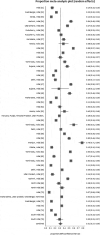COVID-19 vaccine acceptance and hesitancy in Indian context: a systematic review and meta-analysis
- PMID: 38014567
- PMCID: PMC11141315
- DOI: 10.1080/20477724.2023.2285184
COVID-19 vaccine acceptance and hesitancy in Indian context: a systematic review and meta-analysis
Abstract
Vaccination against COVID-19 is vital for achieving herd immunity, and the Government of India has adopted several strategies to achieve coverage. Vaccine hesitancy was identified as a potential obstacle in combating COVID-19. This study aimed to review the COVID-19 vaccine acceptance and hesitancy, and factors associated with vaccine hesitancy based on studies conducted in Indian populations. The data sources (PubMed, Scopus, and Google Scholar) were searched by following PRISMA guidelines, and the search was done in September 2022. We performed a meta-analysis through a random effect model to estimate pooled hesitancy rate with 95% confidence intervals (CI). A total of 3,339 records were searched, of which 46 studies were found to be eligible for inclusion in the review. The included studies covered 65,551 respondents, 55% were female. Studies reported COVID-19 vaccine acceptance rate of 65.7% in January-February 2021, which increased to 92.8% in May-August 2021. Likewise, the rate of vaccine hesitancy in December 2020 was 37%, dropping to 12.1% through November 2021. The estimated pooled COVID-19 vaccine hesitancy was 31% [95% CI: 27% - 36%, I2 = 99.3%]. Most studies highlighted that fear of the vaccine's side effects, efficacy, and safety were major barriers to vaccine acceptance. However, as the review indicates, it is important to consider and address all factors contributing to vaccine hesitancy.
Keywords: COVID-19; India; associated factors; review; vaccine acceptance; vaccine hesitancy.
Conflict of interest statement
No potential conflict of interest was reported by the author(s).
Figures
References
Publication types
MeSH terms
Substances
LinkOut - more resources
Full Text Sources
Medical




